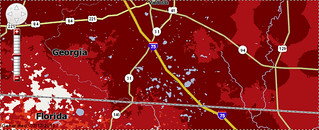It turns out you can’t yet buy
Verizon’s HomeFusion Broadband 4G wireless Internet service
in Georgia.
(You can buy it in Tennessee.)
However, in Georgia, you can buy one of several 4G LTE devices
that have most of the same capabilities.
For example, I have here a
Verizon Jetpack™ 4G LTE Mobile Hotspot MiFi©,
which is about the size of a pack of cards.
A few minutes ago I compared its speeds directly with AT&T 3Mbps DSL.
Here are the results.
The MiFi I’ve got is a slightly older model of the one pictured
above, because for years

AT&T DSL
|

Verizon 4G
|
I’ve been using it and its predecessors
on road trips, for Skype, web browsing, blog posting, etc.
It’s also come in very handy as a
plan B home Internet access method
on the many occassions when AT&T’s DSL has flaked out.
Mostly I did not use it for uploading videos or watching them much,
because until recently it was relatively slow,
using
EVDO technology at about 1Mbps down and 0.7Mbps up.
Suddenly, the MiFi has gotten much much faster, ten times faster,
because Verizon has turned on their 4G LTE service in Lowndes County,
at least for mobile access.
The tables show results using
SpeakEasy Speedtest a few minutes ago.
| Megabytes/sec | Megabits/sec |
|
down | up |
down | up |
|---|
| AT&T DSL |
2.66Mbps |
0.31Mbps |
322KB/sec |
38KB/sec |
| Verizon 4G |
10.88Mbps |
7.14Mbps |
1360KB/sec |
893KB/sec |
Verizon’s 4G LTE is way faster,
as in
Continue reading →
![[Map Phase 1]](http://www.l-a-k-e.org/govt/gbdi/2019-04-26--ga-broadband/map-phase-1.jpg)












